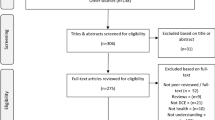Abstract
Previous experimental research in other topic areas has shown that the choice of response alternatives can influence respondents' reporting of the frequency of vaguely defined events and that the set of response alternatives is treated as information in the interpretation of the question. The aim of this study was to examine whether such affects would occur in the context of respondents reporting of health-related events using high and medium frequency closed format response categories, which might be used interchangeably by researchers. The study consisted of a postal survey of n = 518 patients aged ≥≥18 years randomly selected from the patient list of a diabetes centre and who were equally and randomly allocated to one of three conditions (Condition A: high frequency response alternatives/horizontal orientation; condition B: medium frequency response alternatives/horizontal orientations; condition C: high frequency response alternatives/vertical orientation). Testing for the effect of response alternatives for the combined responses of five vaguely defined questions between conditions A and B was χ2 = 5.5, p = 0.019, for the difference in proportions, indicating that overall, those respondents presented with response alternatives discriminating at medium frequency, reported significantly fewer target events than those presented with high frequency response alternatives. Testing for the effect of orientation of the combined question responses between conditions A and C, differences in proportions between conditions, did not reach statistical significance (p > 0.05). Findings from this and previous studies indicate that response alternatives provide information on the interpretation of vaguely defined questionnaire items and that their choice should not be left to intuition alone when designing questionnaire items.
Similar content being viewed by others
References
Lessler JT. Choosing the question that people can understand. Med Care 1997; 33: AS203.
Jenkinson C, Peto V, Coulter A. Making sense of ambiguity: Evaluation of internal reliability and face validity of the SF 36 questionnaire in women presenting with menorrhagia. Qual Health Care 1996; 5: 9–12.
Oksenburg L, Cannell C. Some factors in understanding the validity of self-report. Bull Int Instit 1977; 325–346.
Tourangeau R. Cognitive sciences and survey methods. In: Jabine T, Loftus E, Straf M, Tanur J, Tourangeau R (eds) Cognitive Aspects of Survey Methodology: Building a Bridge Between Disciplines: Washington, DC: National Academy Press, 1984; 73–100.
Sudman S, Bradburn NM. Asking Questions. San Francisco: Jossey-Bass, 1982.
Fowler FJ. Improving Questions. Thousand Oaks, California Sage Publications, 1995.
Schwartz N, Hippler HJ, Deutsch B, Strack F. Response scales: Effect of category range on reported behavior and comparative judgements, Pub Opinion Quart 1985; 49: 388–395.
Schwartz N, Hippler HJ. Response alternatives: The impact of their choice and presentation order: In: Biemer P, Groves RM, Lars E, Lyberg NA, Mathiowetz, Sudman S (eds), Measurement Errors on Surveys. New York: Wiley, 1991.
Burton S, Blair E. Task conditions, response formulation processes, and response accuracy for behavioural frequency questions in surveys. Pub Opinion Quart 1991; 55: 50–79.
Schwartz N, Hippler HJ. What Response Scales May tell Your Respondents: In: Hippler HJ, Schwartz N, Sudman S (eds), Social Information Processing and Survey Methodology. New York: Springer-Verlag, 1987.
Bradburn NM, Sudman S. Improving Interviewing Meth-ods and Questionnaire Design: Response Effects to Threatening Questions in Survey Research. San Francisco: Jossey-Bass, 1979.
Gaskell GD, O'Muircheartaigh CA, Wright DB. Survey questions about the frequency of vaguely defined events. Pub Opinion Quart 1994; 58: 241–254.
Meadows KA, Steen N, McColl E, et al. The Diabetes Health Profile (DHP): A new instrument for assessing the psychosocial profile of insulin requiring patients – Development and psychometric evaluation. Qual Life Res 1996; 5: 242–254.
Goddijn P, Bilo HJG, Meadows KA, et al. The validity and reliability of the Diabetes Health Profile (DHP) in NIDDM patients referred for insulin therapy. Qual Life Res 1996; 5: 433–442.
Schwartz N, Strack F, Muller G, Chassein B. The range of response alternatives may determine the meaning of the question: Further evidence on informative functions of re-sponse alternatives. Social Cognitions 1988; 6: 107–117.
Zigmond A, Snaith RP. The Hospital Anxiety and Depression Scale. Acta Psychiat Scand 1983; 67: 361–370.
Ware J, Snow K, Kosinski M, Gandek B. SF-36 Health Survey Manual and Interpretation Guide. The Health Institute, New England Medical Center, Boston, 1993.
Jobe JB, Mingay DJ. Cognitive laboratory approach to designing questionnaires for surveys of the elderly. Pub Health Rep 1990; 105: 518–524.
Author information
Authors and Affiliations
Rights and permissions
About this article
Cite this article
Meadows, K.A., Greene, T., Foster, L. et al. The impact of different response alternatives on responders' reporting of health-related behaviour in a postal survey. Qual Life Res 9, 385–391 (2000). https://doi.org/10.1023/A:1008971602505
Issue Date:
DOI: https://doi.org/10.1023/A:1008971602505




